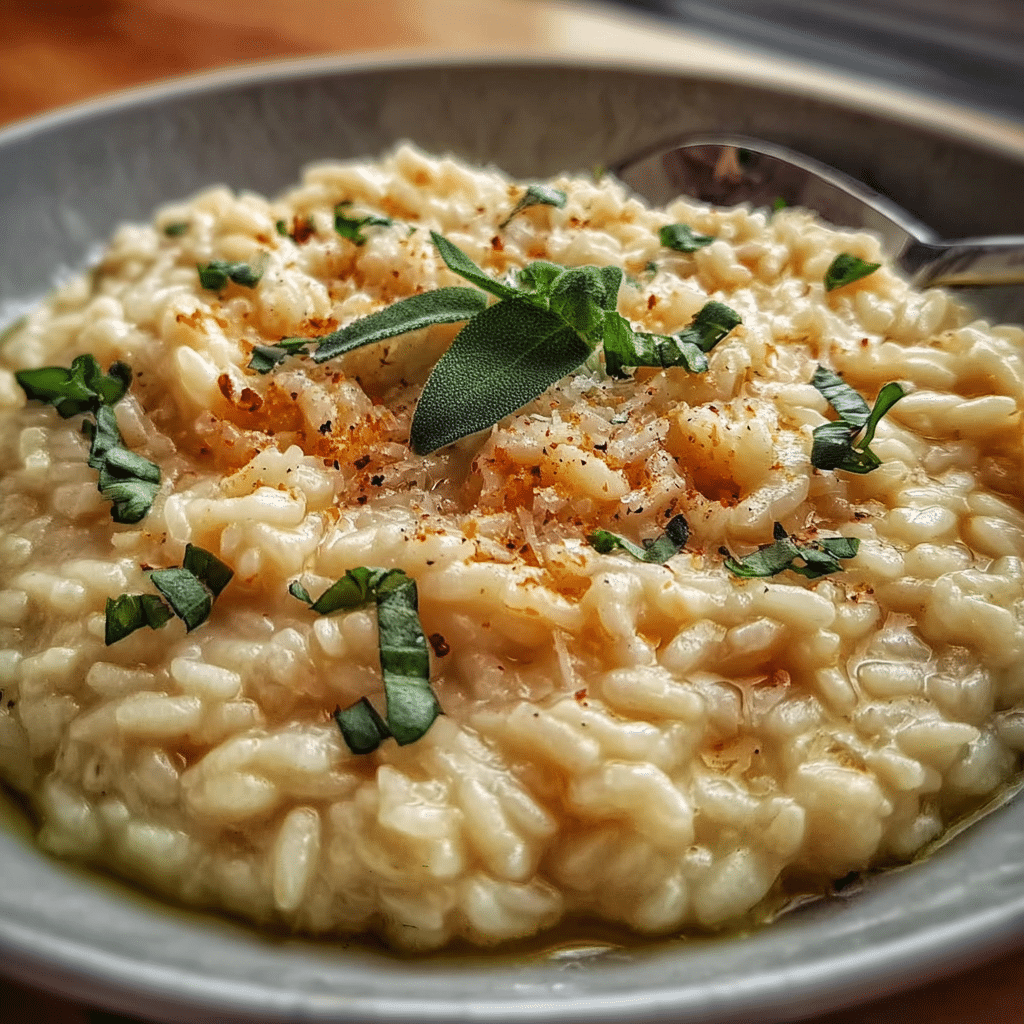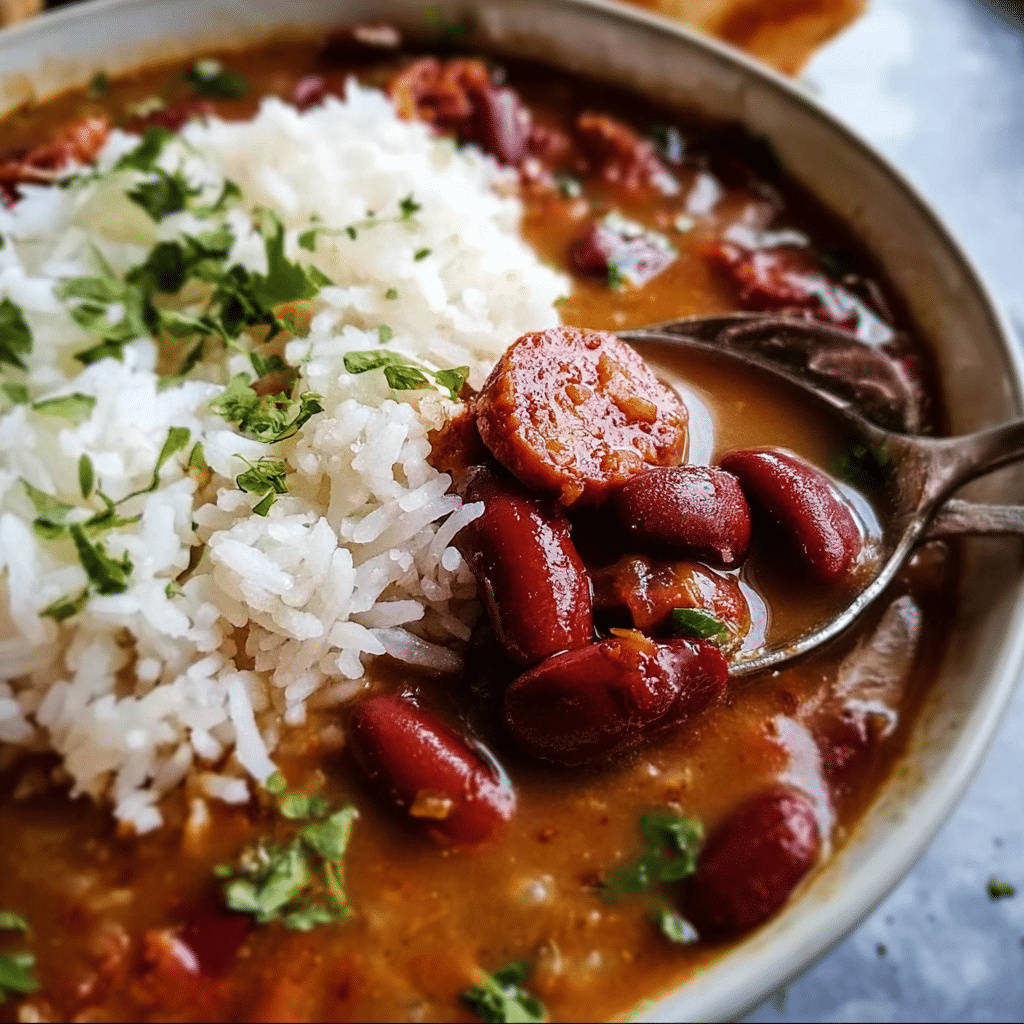White bean sausage is more than just a dish; it’s a warm embrace on a chilly evening, a flavorful reminder of home, and a quick solution for busy weeknight dinners. My love affair with this dish began during a particularly hectic fall when my family was juggling work, school, and the ever-looming holiday season. One evening, as I scoured my recipe collection for something quick yet comforting, I stumbled upon a white bean sausage skillet recipe that promised to deliver on all fronts. Little did I know, this would become a staple in our household, a dish that brought not just nourishment but also a sense of togetherness.

The first time I made white bean sausage, I was overwhelmed with nostalgia. The rich aroma of sautéed onions and garlic wafted through my kitchen, instantly transporting me back to my grandmother’s home, where she would often whip up hearty meals for the family. Each bite of the creamy beans paired with the savory sausage was a reminder of our cozy family dinners, and I realized that this dish was more than just a meal; it was a vessel for cherished memories and stories passed down through generations.
The Story Behind This Recipe
White bean sausage is a beautiful amalgamation of flavors that finds its roots in various culinary traditions. Often associated with Italian and Mediterranean cuisine, this dish showcases the simplicity and richness of utilizing humble ingredients to create something wonderful. Traditionally, white beans, such as cannellini or navy beans, are combined with sausage, which can vary from spicy Italian links to milder chicken sausage, depending on personal preference. It’s a dish that has traveled through time, adapting to different palates and preferences while maintaining its core essence: comfort food that is filling and satisfying.
What makes this recipe particularly special is its versatility. You can easily swap out ingredients based on what you have on hand. While my grandmother’s version featured her homemade spicy Italian sausage, I’ve found that adding seasonal vegetables like kale or spinach not only enhances the nutritional profile but also adds a fresh twist. This ability to adapt is part of what makes white bean sausage a go-to recipe for busy families. On hectic nights when time is of the essence, you can have a nutritious meal on the table in under 30 minutes, all while enjoying the process of cooking together.
Why You’ll Love This Dish
As the leaves turn and the air becomes crisp, there’s an undeniable urge to gather around the dinner table with a hearty meal. White bean sausage is perfect for fall and winter, as it embodies the warmth and comfort we crave during these seasons. It’s not just a dish; it’s an experience, an invitation to slow down and savor the moment with loved ones. The whole process—from sautéing the aromatic vegetables to stirring in the creamy beans—encourages connection, conversation, and a sense of community, making it ideal for family dinners or cozy gatherings with friends.
Readers can expect to learn not only how to craft their own version of white bean sausage but also the nuances that make this dish so beloved. From understanding the best types of beans to use, to tips on selecting the right sausage, this guide will provide everything you need for a successful cooking experience. Plus, I’ll share some personal anecdotes, variations, and serving suggestions that will inspire you to make this dish your own.
In the end, white bean sausage is more than just a recipe; it’s a way to connect with our culinary roots, a vehicle for sharing stories, and a delicious answer to the age-old question of what’s for dinner. So, roll up your sleeves, and let’s dive into the heart of this incredible dish!
The Rich History and Cultural Significance of white bean sausage
The rich history and cultural significance of white bean sausage are as layered as the flavors in the dish itself. Originating from the Mediterranean region, this dish has evolved through time, influenced by various cultures and culinary practices. Understanding its background not only enriches the cooking experience but also connects us to the generations who have enjoyed this meal before us.
Origins and History
White bean sausage can trace its roots back to ancient times when beans were a staple food in many cultures due to their affordability and nutritional value. The earliest mentions of beans in cooking date back thousands of years, with evidence found in both Mediterranean and South American cuisines. In Italy, cannellini beans became particularly popular, often paired with rustic sausages made from pork or other meats. This combination reflects the Italian philosophy of utilizing local and seasonal ingredients, transforming them into hearty, comforting meals.
Over the centuries, variations of white bean sausage emerged across different regions. In France, for instance, the dish became a staple in rural kitchens, often prepared with white beans, sausage, and a range of herbs and vegetables. Similarly, in Spain, a version known as “judías blancas con chorizo” features white beans with the famed Spanish chorizo, highlighting the regional ingredients and flavors that characterize each preparation. As people emigrated and settled in new lands, they brought these culinary traditions with them, adapting them to fit local tastes and available ingredients.
Cultural Significance
White bean sausage is not just a meal; it carries cultural significance in many communities. In Italy, for example, it’s often served during family gatherings and festive occasions, symbolizing togetherness and abundance. Likewise, in rural France, it’s a beloved dish among farmers, providing the hearty sustenance needed for a long day’s work. The preparation of this dish often becomes a communal activity, with families coming together to cook, share stories, and enjoy each other’s company. It’s this cultural connection that transforms a simple recipe into a cherished tradition.
Today, white bean sausage remains a popular dish in homes and restaurants alike. Many renowned chefs have embraced this dish, elevating it with gourmet touches while still honoring its rustic roots. This evolution showcases how cooking traditions can adapt while still preserving their essence, allowing new generations to enjoy them. Michelin-starred establishments often feature their interpretations of this dish, demonstrating its versatility and timeless appeal.
Nutritional Benefits
Beyond its cultural significance, white bean sausage is also packed with nutritional benefits that make it an excellent choice for those seeking a balanced meal. White beans are a fantastic source of plant-based protein, fiber, and essential vitamins and minerals, including iron, magnesium, and folate. They promote digestive health, stabilize blood sugar levels, and provide sustained energy—making them a great option for busy families.
When paired with sausage, which can vary in its nutritional profile depending on the type chosen, white bean sausage can become a well-rounded meal. Opting for leaner sausage varieties, like turkey or chicken, can reduce the fat content while still delivering on flavor. Adding seasonal vegetables not only enhances the dish’s taste but also increases its nutrient density, providing a colorful and healthful balance to the meal.
Ultimately, the journey of white bean sausage is a testament to the beauty of simple ingredients transformed into something extraordinary. Its rich history and cultural significance remind us that food is not just about sustenance; it’s about connection, tradition, and the stories we share around the dinner table. So, as you prepare to make your own version of this heartwarming dish, remember that you are participating in a legacy that spans generations.
Essential Ingredients for Perfect white bean sausage
When it comes to creating a sumptuous dish like a white bean sausage skillet, the ingredients are paramount. Each component contributes not only to the flavor but also to the texture, nutrition, and overall appeal of the dish. In this section, we’ll delve into the essential ingredients you’ll need, their roles in the recipe, and some valuable tips for selecting and storing them.
Essential Ingredients
- White Beans (Cannellini or Great Northern): 2 cups, cooked or canned. These beans are the backbone of our dish, offering creaminess and a mild flavor that pairs beautifully with the spices in the sausage. If you’re using dried beans, soak and cook according to package instructions for optimal texture.
- Sausage: 1 pound, preferably Italian sausage (mild or spicy, depending on your preference). The sausage adds richness and depth to the dish. Look for high-quality, minimally processed options for the best flavor.
- Olive Oil: 2 tablespoons. This not only helps in sautéing the ingredients but also adds a subtle fruity flavor that complements the other components.
- Garlic: 4 cloves, minced. Garlic infuses the dish with aromatic qualities and enhances its savory profile.
- Onion: 1 medium, diced. The sweetness of onions caramelizes beautifully and balances the spiciness of the sausage.
- Bell Pepper: 1 large, chopped. This adds color, crunch, and a slightly sweet undertone to the skillet.
- Spinach: 2 cups, fresh. The spinach not only adds nutritional value but also a pop of color and a touch of earthiness.
- Chicken or Vegetable Broth: 1 cup. This will help create a flavorful base for the dish and enhance the overall taste.
- Spices: 1 teaspoon each of paprika, oregano, and red pepper flakes. These spices elevate the dish, adding warmth and complexity.
- Salt and Pepper: To taste, enhancing the dish’s overall flavor.
Each ingredient in this white bean sausage skillet plays a unique role. The white beans provide a creamy texture and are packed with protein and fiber, making this dish both hearty and nutritious. The sausage, whether you opt for pork, chicken, or a plant-based alternative, brings a savory richness that is hard to resist. Fresh vegetables like onion and bell pepper not only add color but also contribute essential vitamins and minerals. Lastly, the spices awaken the palate and tie all the ingredients together.
Print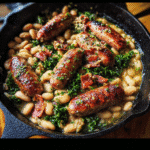
White Bean Sausage Skillet
Ingredients
- 2 tablespoons olive oil
- 12 –14 ounces smoked or Italian sausage links (chicken or pork), cooked, 1/2-inch sliced
- 3 garlic cloves, minced
- 2 (15-ounce) cans white beans, like great northern, butter beans or cannellini, rinsed and drained
- 1 ½ cups chicken stock
- ½ teaspoon kosher salt
- ¼ teaspoon freshly cracked black pepper
- 1 teaspoon minced fresh thyme leaves
- ½ bunch curly kale, stems removed, leaves torn into bite size pieces, about 3 cups packed
- 1 tablespoon lemon juice
- ½ cup parmesan, plus extra for serving
- red pepper fakes, optional
Instructions
- In a 12-inch skillet, heat olive oil over medium-high heat. Add the sausage and cook on both sides until browned, about 4-5 minutes. Set the sausage aside.
- Add the garlic to the pan and cook until fragrant, about 15 seconds. Add ⅔ of the beans and 1 cup of chicken stock to the skillet and season with salt, pepper and thyme, stir to combine and bring to a simmer over medium heat.
- In a medium bowl, smash remaining beans with a fork until a thick paste is formed. Add the smashed beans back into the skillet and stir to combine. Simmer until the beans are heated through and the stock is simmering, about 2-3 minutes.
- Add the kale, reduce the heat to medium-low and cook, stirring often until sauce becomes creamy, is slightly reduced and kale has wilted, about 2 minutes more.
- Add the parmesan, lemon and sausage to the pan. Stir to combine. Add remaining stock a little at a time if you need more creaminess. Adjust seasoning to taste.
- Serve with extra parmesan cheese, red pepper flakes if desired, alongside some crusty bread!
Shopping Tips
Finding quality ingredients is crucial for a delicious white bean sausage skillet. For the beans, if you’re purchasing dried, opt for those that are free from any blemishes and have a consistent color. For canned beans, check the label for minimal additives. When selecting sausage, look for products that have a short ingredient list—ideally, you want natural ingredients without preservatives or fillers. Local butcher shops often carry high-quality sausages that can elevate your dish.
Fresh produce is best when it’s in season. Bell peppers and spinach are generally available year-round, but they are at their peak during the warmer months. Visiting a local farmers’ market can not only yield fresher produce but also support local agriculture and ensure you’re getting seasonal ingredients.
Substitutions and Alternatives
Dietary restrictions or preferences can easily be accommodated in this recipe. For those avoiding meat, consider using plant-based sausage or tempeh, which can mimic the texture and flavor of traditional sausage when seasoned well. If you’re gluten-sensitive, make sure to choose gluten-free sausage options.
For those who may not enjoy beans, you could substitute them with lentils, which will still provide a hearty texture and nutritional value. Additionally, if you’re looking to reduce sodium intake, opt for low-sodium broth and rinse canned beans to remove excess salt. Storage is another important consideration: store leftover beans in an airtight container in the refrigerator for up to three days, and uncooked sausage should be kept in the coldest part of your fridge or frozen for later use.
By understanding the role of each ingredient and how to best select and store them, you can ensure that your white bean sausage skillet not only tastes amazing but is also made with the best quality ingredients available to you.
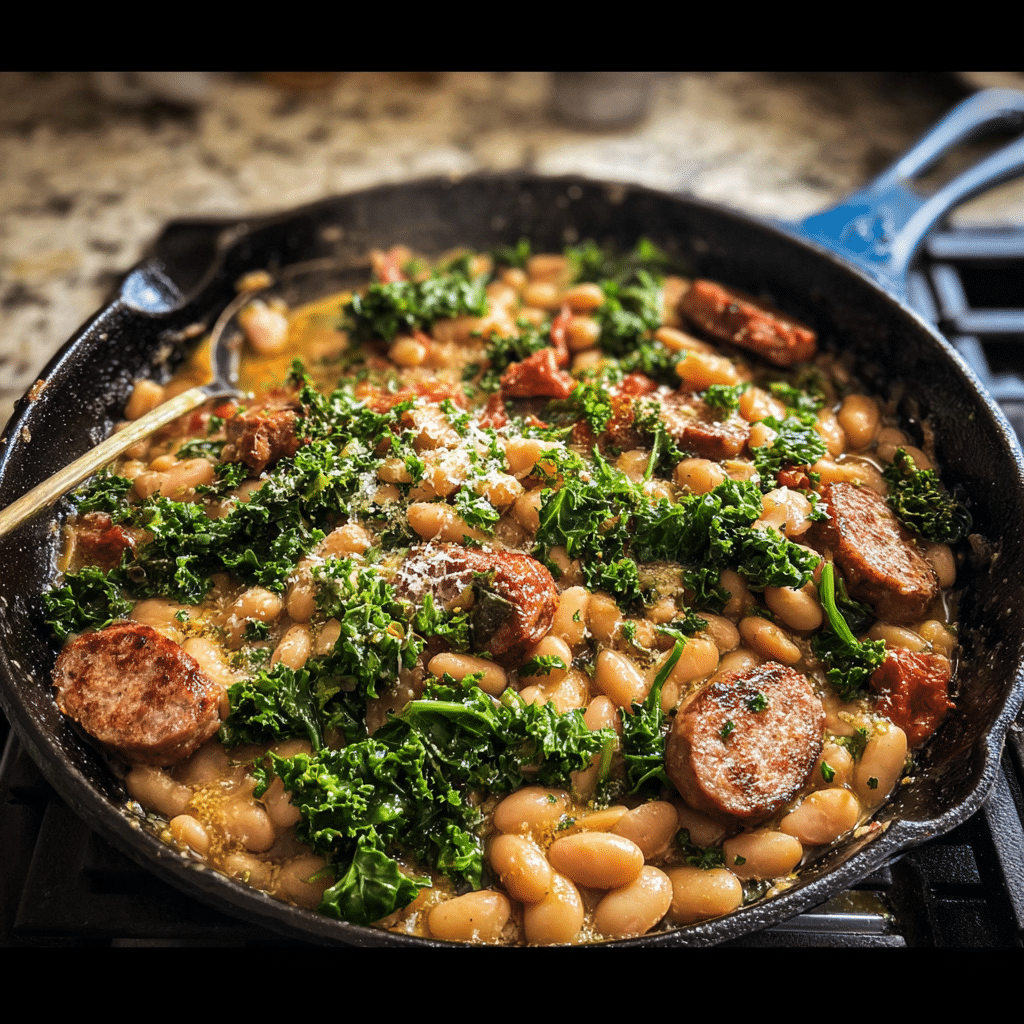
Detailed Step-by-Step white bean sausage Cooking Instructions
Cooking a delicious white bean sausage skillet is not just about following a recipe; it’s about embracing the process and enjoying the experience of creating a meal that warms both the heart and the palate. In this section, I’ll guide you through each step, ensuring you feel confident in your kitchen as you create this mouth-watering dish.
Preparation Steps
- Mise en Place: Start by gathering all your ingredients. This French culinary term means “everything in its place.” Chop your onion, bell pepper, and garlic; rinse and drain your canned beans if using; and have your sausage ready to cook. This step will make the cooking process smoother and more enjoyable.
- Cook the Sausage: In a large skillet over medium heat, add 1 tablespoon of olive oil. Once heated, add the sausage. Use a wooden spoon to break it apart as it cooks. You want to achieve a nice golden color and ensure it’s cooked through, which usually takes about 5-7 minutes. The aroma of sizzling sausage is intensely satisfying and sets the tone for the dish.
- Remove and Set Aside: Once the sausage is browned, remove it from the skillet and set it aside on a plate. This allows the sausage to rest while you prepare the vegetables, ensuring they retain their juiciness.
Cooking Process
- Sauté the Vegetables: In the same skillet, add another tablespoon of olive oil if needed. Toss in the diced onion and bell pepper. Sauté for about 3-4 minutes until the onion is translucent and the bell pepper is tender. The natural sugars in the onion will caramelize, adding depth to your dish.
- Add Garlic and Spices: Stir in the minced garlic and cook for an additional 1-2 minutes. You’ll want to watch closely, as garlic can burn quickly. The moment you smell the garlic, it’s time to add your spices—paprika, oregano, and red pepper flakes. Stir well to coat the vegetables, letting the spices bloom and infuse the oil.
- Incorporate the Beans and Broth: Now it’s time to add the white beans and broth. Stir everything together, scraping the bottom of the skillet to release any delicious browned bits (known as fond) from the sausage and vegetables. Bring it to a gentle simmer, allowing the flavors to meld. This should take about 5 minutes.
Final Assembly
- Return the Sausage: After simmering, add the cooked sausage back into the skillet, stirring to combine everything. This is where the magic of the white bean sausage skillet truly happens as all the flavors come together. You’ll notice the hearty aroma wafting through your kitchen—there’s nothing quite like it!
- Add Spinach: Gently fold in the fresh spinach. It will wilt quickly, so stir just until it’s incorporated and vibrant, which usually takes about 1-2 minutes. This adds a lovely pop of green and nutritional boost to your dish.
- Season to Taste: Before serving, taste your skillet and adjust the seasoning with salt and pepper as needed. It’s a crucial step that ensures the flavors are balanced and to your liking.
- Serve and Enjoy: Your white bean sausage skillet is now ready to be served! Ladle it onto plates or into bowls, and enjoy it with crusty bread or over a bed of rice. The combination of creamy beans, savory sausage, and fresh vegetables creates a comfort food experience that will leave you satisfied.
As you cook, remember that the beauty of this dish lies not just in the ingredients but in the love and care you put into it. Cooking is an art, and there’s no right or wrong way—just your way. Whether you’re making this for a weeknight family meal or a cozy dinner with friends, the white bean sausage skillet is a dish that brings people together. Enjoy every bite and the memories created around the table!
Professional Tips and Techniques for white bean sausage
When it comes to cooking, especially dishes as hearty and soul-satisfying as white bean sausage skillet, having the right techniques and tips up your sleeve can elevate your dish from good to absolutely extraordinary. Over the years, I’ve gathered a treasure trove of professional tips that will not only help you master this dish but also make the cooking process more enjoyable. Let’s dive into some of these invaluable insights!
Professional Techniques
One of the cornerstones of a delicious white bean sausage skillet is the quality of your ingredients, but equally important are the techniques you use. Start with the sausage: whether you’re using Italian sausage, chicken sausage, or a plant-based alternative, ensure you brown it well. This caramelization adds depth and flavor to your dish. Use a cast iron skillet for the best heat retention and browning. Preheat it on medium-high before adding your sausage to achieve that perfect sear.
Next, don’t rush the onions and garlic. In the same skillet, after removing the sausage, add a drizzle of olive oil, then toss in the diced onions. Let them sweat slowly until they become translucent and golden, which usually takes about 5-7 minutes. This step is crucial as it builds the foundation of flavor in your white bean sausage creation. Afterward, add minced garlic for the last minute to avoid burning and bitterness; garlic should be fragrant but not browned.
In terms of cooking the beans, if you’re using canned beans, rinse them thoroughly to remove excess sodium. If you’re using dried beans, soak them overnight and cook them until tender before adding to your skillet. This extra step will ensure your beans achieve the perfect texture and flavor, seamlessly blending with the sausage.
Troubleshooting Guide
Even the most seasoned cooks encounter bumps in the road. Here are some common issues and how to fix them. If your white bean sausage skillet turns out too dry, consider adding a splash of broth or wine to loosen up the dish. This not only adds moisture but also enhances the flavor profile. Conversely, if it’s too soupy, you can simmer it uncovered for a few minutes to reduce excess liquid.
Another common problem is uneven cooking. Ensure that your sausage pieces are uniform in size so they cook evenly. If you find that your beans are mushy, it may be due to overcooking; keep an eye on them, especially if you’re using dried beans. Always taste as you go to ensure the right texture and flavor balance.
Presentation Tips
A beautiful presentation can make your white bean sausage skillet even more appetizing. Consider serving it directly in the skillet for a rustic look; this not only keeps the dish warm but also adds a communal feel to the meal. To elevate the presentation, top your dish with freshly chopped herbs such as parsley or basil just before serving. A sprinkle of crumbled feta or a drizzle of balsamic glaze can add a delightful finishing touch.
When plating, consider pairing your skillet with a side of crusty bread or a fresh green salad to create a balanced meal. The colors of the dish—golden sausage, creamy white beans, and vibrant greens—create an eye-catching contrast that is sure to impress your guests.
As for beverage pairings, a crisp white wine, such as Sauvignon Blanc, complements the flavors of the white bean sausage beautifully. Alternatively, a light lager or a refreshing iced tea can also be a great match, providing a nice balance to the savory elements of the dish. Cheers to a wonderful meal!
Creative Variations and Adaptations of white bean sausage
One of the most exciting aspects of cooking is the ability to adapt and innovate, especially with a versatile dish like white bean sausage skillet. The foundation of this dish is solid, but don’t hesitate to make it your own with creative variations and adaptations. Let’s explore some delightful twists you can incorporate!
Seasonal Variations
Seasonality is key in cooking, and the white bean sausage skillet is no exception. In the spring, consider adding fresh asparagus or peas, which add a pop of color and a fresh taste. Summer is the perfect time to incorporate zucchini or bell peppers, sautéing them alongside the onions for a burst of flavor. Autumn brings a wonderful opportunity to include roasted butternut squash or sweet potatoes, which pair beautifully with the savory sausage. In the winter, hearty greens like kale or Swiss chard can be added for a nutritious boost.
Don’t forget about herbs! Fresh herbs like basil in the summer or thyme and rosemary in the colder months can significantly enhance the flavor profile of your dish. Always let the season guide your ingredient choices, and your white bean sausage skillet will never feel repetitive.
Dietary Adaptations
Whether you’re cooking for yourself or guests, dietary preferences can vary, but that shouldn’t mean sacrificing flavor. For a low-carb or keto-friendly version, you can substitute traditional sausage with turkey sausage or a plant-based sausage option and omit the beans altogether, adding in more veggies like cauliflower or mushrooms. If you’re catering to a vegan diet, there are fantastic plant-based sausages available that mimic the flavors and textures of meat beautifully. Just ensure to use vegetable broth instead of chicken broth to maintain the vegan aspect.
If gluten is a concern, check the labels on your sausages and opt for gluten-free varieties. The beans in this dish are naturally gluten-free, making it easy to adapt without losing the heartiness that defines a good skillet meal.
Creative Twists
Why not take your white bean sausage skillet on an international journey? Think Mediterranean with a splash of lemon juice and a handful of olives, or go Mexican with the addition of cumin, cilantro, and a hint of lime. You could even transform your dish into an Italian classic by incorporating tomatoes and serving it over polenta or pasta.
Another fun twist is to experiment with different cooking methods. If you’re short on time, a slow cooker can work wonders. Just toss all your ingredients in and let it simmer while you go about your day. For a smoky flavor, try grilling your sausage before adding it to the skillet—this adds an entirely new dimension to your meal.
And let’s talk leftovers! If you find yourself with extra white bean sausage skillet, consider turning it into a hearty soup. Simply add some broth and vegetables, heat it up, and you have a completely new meal ready to enjoy. This not only minimizes waste but also gives you the chance to enjoy a different take on a beloved dish.
With these creative variations and adaptations, you can ensure that your white bean sausage skillet remains a staple in your kitchen, evolving with your tastes and the seasons. So, roll up your sleeves and get ready to experiment—cooking should always be a fun and creative process!
Storage, Reheating, and Meal Prep for white bean sausage
When it comes to preparing a delicious white bean sausage skillet, knowing how to properly store and reheat it can make all the difference in enjoying that savory dish again! Whether you’ve made a generous batch for family or just have some leftovers, understanding the nuances of food storage can help maintain the flavors and textures that make this dish so special.
Short-term Storage
After you’ve cooked up your scrumptious white bean sausage skillet, you may find yourself with some leftovers (if you’re lucky!). To keep your meal fresh, it’s essential to store it properly. Start by letting the skillet cool down to room temperature. This is crucial as placing hot food directly into the fridge can raise the overall temperature inside, potentially putting other food at risk of spoilage.
Once cooled, transfer your white bean sausage into an airtight container. Glass containers with tight-fitting lids work wonders for maintaining flavor and preventing leaks. If you’re using plastic containers, make sure they are BPA-free and suitable for food storage. Try to minimize the air exposure by filling the container as much as possible—this helps to prevent freezer burn if you decide to store it for an extended period.
In the refrigerator, your white bean sausage skillet will stay fresh for about 3 to 5 days. Make sure to label your container with the date so you can keep track of its freshness. If you’re ever in doubt, give it a sniff; if it smells off, it’s best to toss it out.
Freezing and Long-term Storage
If you’ve made a larger batch of white bean sausage or simply want to save some for later, freezing is a fantastic option. Freezing not only extends the shelf life but also preserves the flavors of the dish. The key to successfully freezing your white bean sausage skillet is to ensure that it is cooled completely before packing it away.
For freezing, consider breaking it down into meal-sized portions. Use freezer-safe bags or containers, and don’t forget to remove as much air as possible—vacuum-sealing is an excellent choice if you have the equipment. Label each portion with the date and contents. Your white bean sausage can be stored in the freezer for up to 3 months without significant loss of quality.
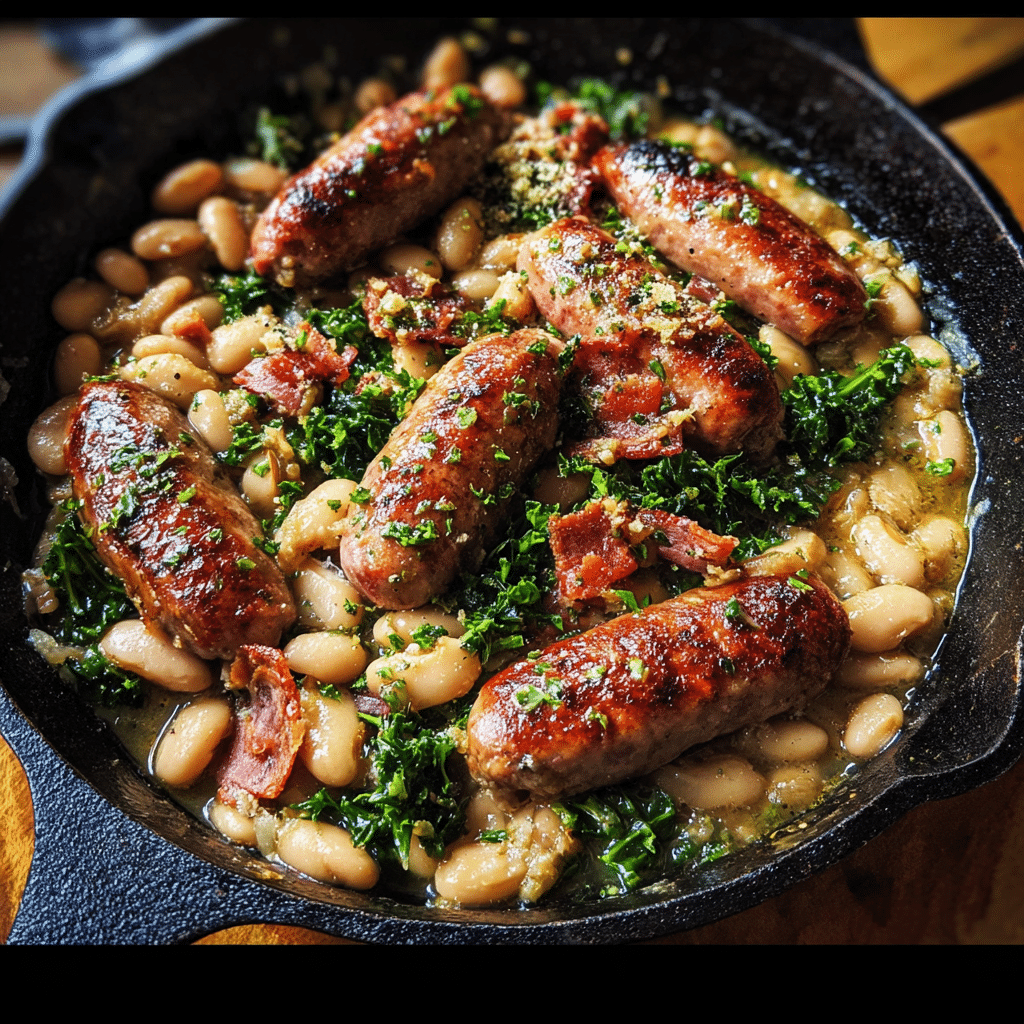
When you’re ready to enjoy your frozen white bean sausage skillet, the best method is to thaw it overnight in the refrigerator. This gradual thawing helps maintain the texture and flavor. If you’re short on time, you can also use the microwave on the defrost setting. Just be sure to stir occasionally to promote even thawing. Once thawed, reheat on the stovetop or in the microwave until heated through.
Reheating Best Practices
Reheating your white bean sausage skillet can be done in several ways, but to retain the best quality, the stovetop is your best bet. Simply place the skillet over medium heat, adding a splash of broth or water to help steam and revive the dish’s moisture. Stir occasionally until heated through. This method ensures that the beans and sausage don’t dry out and the flavors meld beautifully once again.
If you’re in a hurry, the microwave is a decent alternative. Place your portion in a microwave-safe bowl, cover it (but leave a small vent), and heat in intervals of 1 to 2 minutes, stirring in between. This helps to ensure even heating without creating hot spots that can toughen the sausage or dry out the beans.
For those looking to meal prep, the white bean sausage skillet is a perfect candidate! You can prepare a large batch over the weekend and portion it out for easy lunches or dinners throughout the week. Just be sure to store them properly as mentioned earlier, and you’ll have a delightful, nutritious meal ready to go whenever hunger strikes.
Food safety is paramount when it comes to storing and reheating food. Always use your senses—sight, smell, and taste—to assess the quality of your leftovers. If anything seems off, it’s better to be safe than sorry. Remember, the shelf life for refrigerated leftovers is generally 3 to 5 days, while frozen meals can last for several months.
In conclusion, mastering the storage, freezing, and reheating of your white bean sausage skillet not only allows you to enjoy it multiple times but also enhances your cooking experience. With these tips in hand, you can confidently make this dish a staple in your kitchen, knowing that you can savor it in the days to come!
Nutritional Benefits and Health Information
Let’s talk about why the white bean sausage skillet is not only a feast for the taste buds but also a powerhouse of nutrition. Understanding the health benefits of the ingredients used in this dish can inspire you to incorporate it into your regular meal rotation. With a delightful combination of flavors and textures, this dish marries nutrition with comfort food, making it a beloved choice for many.
Nutritional Profile
To get started, let’s break down the nutritional components of the key ingredients typically found in a white bean sausage skillet. The star of the show, of course, is the white beans. Rich in protein and dietary fiber, these legumes provide a hearty base for your dish. A cup of cooked white beans contains approximately 17 grams of protein and 11 grams of fiber, which aids digestion and helps you feel full longer.
Next up is the sausage. While the nutritional value can vary significantly based on the type of sausage you choose—whether it be turkey, chicken, or a plant-based alternative—most sausages provide a good source of protein as well. For instance, a typical pork sausage may contain around 20 grams of protein per serving, but it can also be high in saturated fat and sodium. Opting for leaner sausages can help balance the dish more healthfully.
In addition to beans and sausage, you might include vegetables like bell peppers, onions, or spinach, each contributing their own set of vitamins and minerals. For example, bell peppers are rich in vitamin C, which is vital for immune health, while spinach is packed with iron and calcium.
Health Benefits
Now that we’ve explored the nutritional profile, it’s essential to highlight the specific health benefits of the ingredients in your white bean sausage skillet. The fiber found in white beans can significantly aid in regulating blood sugar levels, making this dish a great choice for those managing diabetes. The protein content supports muscle health and repair, which is especially beneficial for active individuals or those engaging in regular exercise.
Moreover, the combination of protein and fiber can help with weight management. Meals rich in these nutrients promote satiety, reducing the likelihood of overeating later in the day. The inclusion of vegetables not only enhances the flavor but also boosts the vitamin content of the meal, contributing to overall well-being.
Furthermore, if you choose a sausage that is seasoned with herbs and spices, you can benefit from their anti-inflammatory properties. Ingredients like garlic and onion have been shown to promote better heart health and boost immunity, which is another reason to feel good about your white bean sausage skillet.
Dietary Considerations
When it comes to dietary restrictions, the white bean sausage skillet can be quite versatile. For those following a gluten-free diet, simply ensure that the sausage you select is gluten-free, and you’re good to go! For vegans or vegetarians, swapping out the sausage for a plant-based alternative can maintain the heartiness of the dish while keeping it meat-free. You can also explore using different beans or lentils for a unique twist.
If you’re counting calories, it’s worth noting that a standard serving of white bean sausage skillet can range between 300 to 500 calories, depending on the ingredients and portion sizes. However, it’s important to remember that the dish is nutrient-dense, meaning you’re getting a lot of vitamins and minerals for that caloric intake.
In terms of healthy modifications, consider using low-sodium broth instead of regular broth to reduce sodium levels, or try baking the sausage instead of pan-frying to cut down on added fats. Incorporating more vegetables can also enhance the dish’s nutritional value without significantly increasing calories.
In comparison to similar dishes, such as chili or casseroles, the white bean sausage skillet stands out because it offers a balanced meal in one pan. Many similar dishes can be heavy on carbs or fats, whereas this skillet provides a wholesome mix of protein, fiber, and essential nutrients, making it a smart choice for a nutritious dinner.
In summary, the white bean sausage skillet not only satisfies your taste buds but also caters to your nutritional needs. With its rich protein content, fiber, and array of vitamins and minerals, it’s an excellent addition to any diet. Whether you’re looking to maintain a healthy lifestyle or simply enjoy a comforting dish, this skillet is sure to deliver on all fronts!
Frequently Asked Questions About White Bean Sausage
What is a white bean sausage skillet recipe?
A white bean sausage skillet recipe is a one-pan dish that combines white beans, such as cannellini or navy beans, with sausage and various vegetables, creating a hearty and flavorful meal. To make this dish, start by browning your choice of sausage in a skillet, then add diced onions, garlic, and bell peppers to caramelize. Incorporate drained and rinsed white beans, along with spices like thyme and paprika, and simmer everything together for about 15-20 minutes. For added depth of flavor, consider deglazing the pan with a splash of white wine or broth. Finish with fresh herbs like parsley or basil for a burst of freshness before serving.
How do I make a sausage and cannellini bean cassoulet?
A sausage and cannellini bean cassoulet is a comforting dish that features slow-cooked sausage and beans in a rich sauce. Begin by sautéing onions, carrots, and garlic in a large oven-safe pot until softened. Add in sliced sausage, such as smoked sausage or chorizo, and cook until browned. Next, stir in drained cannellini beans, diced tomatoes, and a mix of herbs like thyme and bay leaves, then pour in chicken or vegetable broth. Allow the mixture to simmer for at least 30 minutes, then transfer it to the oven to bake at 350°F for another 30 minutes, which will meld the flavors beautifully. For a crispy topping, consider sprinkling breadcrumbs mixed with a little olive oil before baking.
What can I make with canned white beans and sausage?
Using canned white beans and sausage opens up a world of quick and delicious meal options. One simple approach is to combine sliced sausage with garlic and onion in a skillet, then add the drained and rinsed canned beans along with some diced tomatoes and spices. This creates a hearty stew-like dish that can be served over rice or with crusty bread. Alternatively, you can make a quick pasta dish by tossing cooked pasta with the sausage and beans, adding olive oil, lemon juice, and fresh spinach for a nutritious meal. Remember to adjust seasoning to taste, as canned beans can sometimes be a bit salty.
How can I prepare a white bean sausage pasta?
To prepare a white bean sausage pasta, start by cooking your favorite pasta according to package instructions. While the pasta cooks, heat a skillet and add sliced sausage, cooking until browned and crispy. Then, add minced garlic, diced tomatoes, and drained white beans to the skillet, allowing them to heat through and infuse flavors. Combine the cooked pasta with the sausage and bean mixture, adding a splash of pasta water to create a cohesive sauce. For a finishing touch, toss in fresh herbs, such as basil or parsley, and a sprinkle of grated Parmesan cheese for extra flavor. This dish is not only easy to make but also incredibly satisfying!
Conclusion: Mastering the Perfect white bean sausage
Creating the perfect white bean sausage is more than just following a recipe—it’s about understanding the techniques, ingredients, and cultural significance behind this beloved dish. Throughout this comprehensive guide, we’ve explored everything from the historical origins to modern variations, ensuring you have all the knowledge needed to make this recipe your own.
Whether you’re a beginner cook or an experienced chef, the techniques and tips we’ve shared will help you create a white bean sausage that’s not only delicious but also meaningful. Remember that cooking is a journey of discovery, and each time you make this dish, you’ll learn something new.
We encourage you to experiment with the variations we’ve discussed, adapt the recipe to your dietary needs, and most importantly, share it with the people you love. Food has the incredible power to bring people together, and White Bean Sausage Skillet is the perfect dish to create lasting memories around your dinner table.


